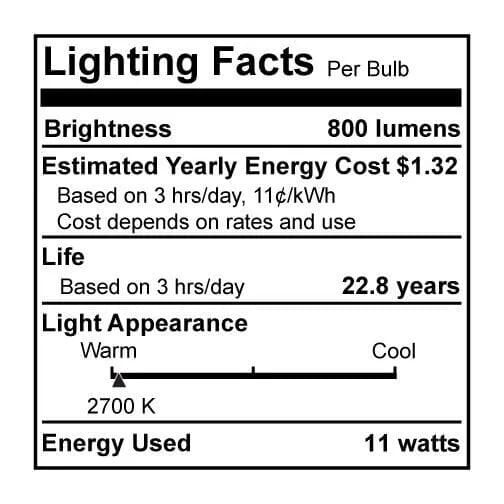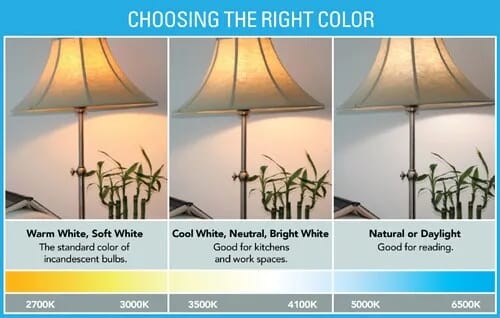While LED lights themselves do not produce any heat, as a category they represent one of the hottest new trends in residential and commercial lighting! LED lights might have more in common with your TV than with the other light bulbs you have. That’s because LEDs are semiconductor devices that can produce directed light in an extremely efficient manner.
The History of LED Lights
LEDs had a humble beginning as indicator lights inside electronic devices like DVD players and laptops. Only when the blue LED light was invented did LEDs become viable for other applications. That’s because there’s no such thing as a white LED light. Instead, white is created by combining the colors red, green and blue.
LED technology has come a long way in recent years as engineers have learned how to harness the very directional nature of most LED light sources, allowing it to be used in applications that require a wider splash of light.
LEDs are most commonly found today in applications such as under-cabinet lights, landscape lighting, cove lighting or in lighting a tray ceiling. Their slim design means they are extremely versatile and can be used in light fixture designs that were not previously possible. Take LED tape light, also known as LED strip lights–a design so slender that it can go practically anywhere! The fixture shown below is made possible by using LED.

As the cost of using LED decreases, expect to see even more eye-catching and innovative uses of LED lights, especially in fixtures where the light sources are integrated or embedded. (For example, the pendant pictured above has a design made possible through the use of LED lights.)
LED Lights and Energy Efficiency
LEDs often have a phenomenal efficacy rating, with some achieving ratings of 100 lumens per watt, abbreviated LPW. By comparison, fluorescents can average closer to 60 LPW while incandescents typically come in at 15 LPW. They also have a particularly long life (sometimes more than 20 years), making them an attractive option for hard-to-reach places such as a vaulted ceiling or outdoor applications. On the downside, LED technology changes frequently, which can render previous product offerings obsolete. Bulbs are also more expensive than their incandescent and fluorescent counterparts, but offer long-term savings on energy costs.
The U.S. Department of Energy estimates that the widespread use of LEDs over the next 20 years would save a total of about $265 billion in energy costs.
Unlike incandescents and fluorescents, LEDs will also typically dim slowly over time, rather than “burning out” all at once. Again, think of your television set, which typically phases itself out in a similar manner. An LED’s life is measured on a prediction of how long it will take for the light output to decrease 30 percent.
Lighting Facts Label and LEDs
All light bulb boxes, including LEDs, now feature a black-and-white Lighting Facts label that give you all the facts to help you make the right buying decision. Let’s take a look at a sample Lighting Facts label and go through what is included in it.

Brightness
If you want to know how bright a light is going to be, you need to become friends with lumens because, unlike the watt, lumens are how you measure brightness. (We’ll talk about the watt later.)
What are lumens? Lumens are the raw quality of light given off by a light source. Or, to put it a different way, lumens measure a light’s brightness. All common electrical sources have a lumen rating, including incandescent, fluorescent and LED sources. Remember it this way: the higher the lumens, the brighter the light.
Here’s a cheat sheet you can use to figure out how many lumens you should look for in a light source. In an incandescent bulb, the wattages shown in this chart will provide the following brightness in lumens.
| Watts | Lumens |
|---|---|
| 100 watts | 1600 lumens (range of 1490 to 2600 lumens) |
| 75 watts | 1100 lumens (range of 1050 to 1489 lumens) |
| 60 watts | 800 lumens (range of 750 to 1049 lumens) |
| 40 watts | 450 lumens (range of 310 to 749 lumens) |
Many light sources in your home fall between the 60 and 100 watt range, which is the 800 to 1600 lumen range.
Estimated Yearly Energy Cost
This estimates how much it will cost you each year to power this light bulb. The estimation is based off a hypothetical usage of 3 hours a day and an energy cost of 11 cents per kilowatt. You might use this bulb for more or fewer hours a day and your energy cost per kilowatt might be higher or lower. Want a more detailed version of this energy cost calculation that you can tailor to your specifics? Check out the LED Waves Bulb Savings Calculator.
Life
This estimates how long the light source will last before you need to replace it. Like the estimated energy cost, this is also based on a use of 3 hours a day. Once again, your mileage may vary. Incandescent bulbs have an estimated life of about a year.
Light Appearance
Also known as color temperature, this is measured on a scale of degrees Kelvin, hence the large numbers with the K. 2700K is a warm, yellow-white light. 2700K is what standard incandescent light sources typically create. As you go up the sliding scale, the numbers grow higher and the color of light grows cooler, meaning it goes from yellow to white to blue. (Fun fact: A cloudy day has a very high color temperature.)
Sometimes it’s easier to see these things side by side, so here’s an example!

You can find LEDs in a wide variety of color temperatures, which means that if you like the warm white glow you’d get from incandescent bulbs, you can find that in LED varieties too! But if you prefer something in a cool white, something more like a fluorescent light, don’t worry because there are LED sources to fit that bill too.
Energy Used
Remember, watts are used to measure energy, not brightness! However, watts are important since you never want to put more watts in a fixture than it can safely handle. Otherwise, you could blow fuses or start a fire. To help find a light source that will save you money on energy and give you an ideal brightness, look for one with the lumens you want and, with that number in mind, find a source with a lower wattage.
If you still have questions, feel free to contact us at 1-866-688-3562 or on social media.
Sign up for our email newsletter today and score an additional discount!
You can also read all about incandescent lights and all about fluorescent lights.





February 18, 2020
The other type of LED backlighting is referred to as Full-Array (also referred to sometimes as Full LED)
April 5, 2020
I found really helpful information about led lights in this website, thanks to them for publishing such valuable information for us. Thanks
May 7, 2021
[…] fluorescents, LEDs and even halogen bulbs are more energy-efficient, many consumers still prefer incandescent lights […]
October 5, 2022
[…] lighting is also becoming more popular because of LED lights. Incandescent lights give off a lot of heat and that heat could scorch the soft alabaster over […]